Besides size classification, all the way from extra large to peewee and grade classifications from AA, A to B, they come in white, brown, fertile, free range, cage free, vegetarian diet, nutrition enhanced, which includes, but is not limited to, omega-3 , organic, pasteurized and combinations of the above. Then you have whole eggs, egg yolk or egg white in cartons already pasteurized. Conceivably, you can have peewee B brown fertile cage free vegetarian diet pasteurized organic eggs. The eggs I use here are Whole Food’s large brown cage free fertile produced without antibiotics or synthetic pesticides with a very light yolk color. The color of the egg shell is determined by the breed of the hen. Breeds with white feathers and ear lobes lay white eggs; breeds with red feathers and ear lobes lay brown eggs. Color of the yolk depends on the diet of the hen. If she gets plenty of yellow-orange plant pigments known as xanthophylls, they will be deposited in the yolk. Hens fed mashes containing yellow corn and alfalfa meal lay eggs with medium yellow yolks, while those eating wheat or barley yield lighter-colored yolks. A colorless diet, such as white cornmeal produces almost colorless yolks. Natural yellow-orange substances such as marigold petals may be added to light-colored feeds to enhance yolk color. I am as confused as anyone reading this article and dare not venture to say which egg is best for you in terms of nutritional value. Pick eggs that you are comfortable with and within your budget.
Related Articles
Main ingredients:
4 large eggs – slightly less than 1 cup (200 g).
12 medium sized fresh little neck clams. Try to pick clams of about the same size for uniform cooking. The best way to determine the freshness of clams is by touching the clams while they have their incurrent and excurrent siphons sticking out. Freshness is determined by the speed with which they retract: the faster, the better. If no siphons are visible, touch clams that are slightly open and determine their freshness by the speed with which they close. A third way is to pick clams that are closed. (If you cannot find fresh clams, then use about 1/4 to 1/3 cup of canned ocean clam meat.)
Approximately 1-1/4 to 2-1/2 cups of canned clam juice (If you used canned clam meat instead of fresh clams, you can also use the clam juice contained in the same can.)
3 drops of vinegar. Vinegar is used to promote the binding of the egg protein with the liquid. You can skip it if you prefer not to use it, but 3 drops is not going to impart an acidic taste to the custard.
1 tablespoon of sake or cooking wine. I prefer to use sake because cooking wine found at Chinese grocery stores usually contain salt.
large pinch of white pepper. White pepper is used instead of black pepper because of its color and delicate taste. Black pepper can be substituted if dark speckle in the custard is not objectionable.
1 scallion
Equipment needed:
Fine strainer
4 heatproof bowls (about 8 oz. each) to hold the custard
whisk or egg beater
double boiler to cook the custard
mini alligator dicer to julienne the scallion – from Williams Sonoma or other home cookware stores.
Preparation:
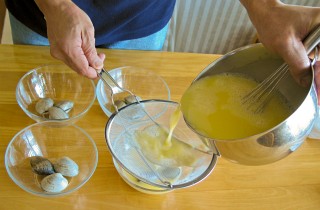 Wash the clams and place 3 each to a bowl. If chopped clams are used, divide the clams into 4 portions and place them in the bowls. Beat eggs; add wine, white pepper and vinegar. If this is a main course, then add clam juice equal to 2 ˝ times the volume of beaten eggs. If this is an appetizer, then replace half of the clam juice with water. Strain the liquid and pour into the bowls.
Wash the clams and place 3 each to a bowl. If chopped clams are used, divide the clams into 4 portions and place them in the bowls. Beat eggs; add wine, white pepper and vinegar. If this is a main course, then add clam juice equal to 2 ˝ times the volume of beaten eggs. If this is an appetizer, then replace half of the clam juice with water. Strain the liquid and pour into the bowls.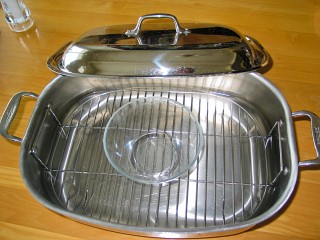 Bring water in the double boiler to a boil. (Place enough water in the double boiler so that the bowls will have slight contact with the water).
Bring water in the double boiler to a boil. (Place enough water in the double boiler so that the bowls will have slight contact with the water).Place bowls in double boiler and boil for 1 minute. Turn heat to low and cook for an additional 20 minutes or until done. Using chopped clams should cut the cooking time by a few minutes. The custard is done when you see bulging of the custard (due to the opening of the clamshells) and the custard acts like jello. For chopped clams, there will be no bulging.
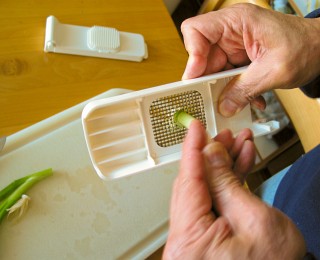 Push and pull scallion carefully through the mini alligator dicer, as shown in photos. Because the blades on the alligator dicer are very sharp, care should be taken when pushing and pulling the scallion through. I recommend pushing and pulling the scallion until it is most of the way through and either cutting it off or using another piece to finish the job.
Push and pull scallion carefully through the mini alligator dicer, as shown in photos. Because the blades on the alligator dicer are very sharp, care should be taken when pushing and pulling the scallion through. I recommend pushing and pulling the scallion until it is most of the way through and either cutting it off or using another piece to finish the job.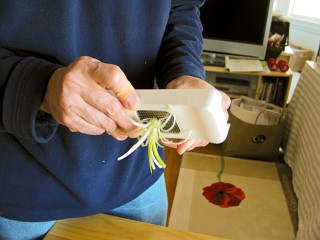
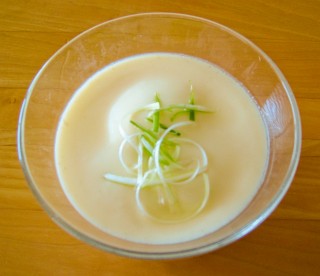 Garnish with julienned scallion.
Garnish with julienned scallion.Egg Custard with Clams (serves 4 as appetizer or main course)
| 12 medium sized fresh little neck clams | wash, place in bowls | pour into bowls | cook in water bath on high heat 1 min | cook in water bath on low heat approx. 20 min | garnish | ||
| 4 large (200 g) eggs | beat | stir together | strain | ||||
| 1 Tbs. sake | |||||||
| 3 drops vinegar | |||||||
| large pinch white pepper | |||||||
| 1-1/4 cup clam juice | |||||||
| 1-1/4 cup clam juice (main course) or 1-1/4 cup water (appetizer) | |||||||
| 1 scallion | julienne | ||||||
George Chow loves to cook because he loves to eat good food.
Related Articles

I'm pretty sure you would, since you need liquid in the eggs to make it into a custard consistency.
also interesting to note that the diet plays a big part in the yolk color. i would love to get some very pale yolks to the one that you mentioned to be almost colorless. too bad, i don't think it's available locally.
Nowhere can I find a double boiler that looks remotely like the one used here and certainly nothing that big.
What brand? Where can I get one?
Nowhere can I find a double boiler that looks remotely like the one used here and certainly nothing that big.
What brand? Where can I get one?
I looked at the pictures again and it looks like George is using an All-Clad French Oven roasting pan with rack insert. Technically this would be a water bath and not a double boiler - which may lead to the difficulty in finding this piece of equipment.
i think what percentage you push and pull depends on the freshness of the scallions - if they are firm, it will be easier to push it through whereas if they are limp, you need to do as you described here - push a little and try pulling it out. i think it is a matter of what you are comfortable with.
i think this dish is best to be eaten while it is still hot. if you need to re- heat it, try warming it up in a hot water bath.
If they remain relatively closed then I would ask:
How do you know if the clam was dead in its shell before you cooked it?
Yes, you can check for cracks or chips and clean them and such but the only true test is if they open when they are cooked.
If they are able to open before the custard sets enough to keep them closed then I whole-heartedly withdraw this objection to the recipe.
If they do not then I must mention that food-poisoning is extremely dangerous and has the possibility to be fatal. (Not normally but possible.)
As for my next mention...
Custards in general should not be reheated. It changes the consistency and quality so much that I would never suggest it.